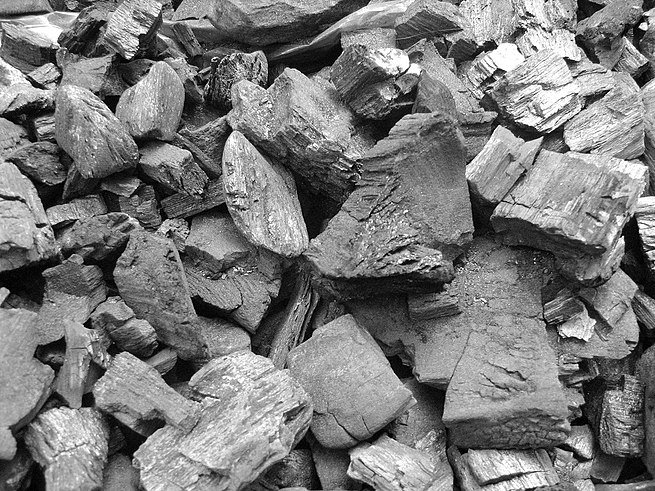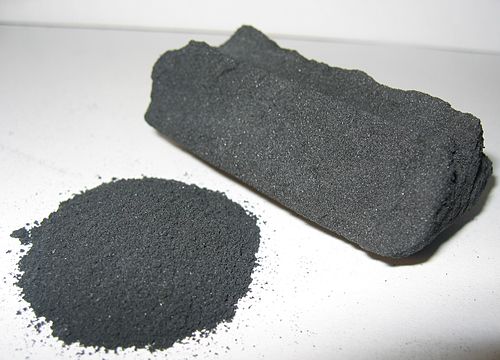Carbonnoun
(uncountable) The chemical element (symbol C) with an atomic number of 6.
Carbonnoun
(countable) An atom of this element, in reference to a molecule containing it.
Carbonnoun
A sheet of carbon paper.
Carbonnoun
A carbon copy.
Carbonnoun
A fossil fuel that is made of impure carbon such as coal or charcoal.
Carbonnoun
Carbon dioxide, in the context of global warming and climate change.
Carbonnoun
A carbon rod or pencil used in an arc lamp.
Carbonnoun
A plate or piece of carbon used as one of the elements of a voltaic battery.
Carbonverb
To cause (someone) to receive a carbon copy of an email message.
Carbonnoun
An elementary substance, not metallic in its nature, which is present in all organic compounds. Atomic weight 11.97. Symbol C. it is combustible, and forms the base of lampblack and charcoal, and enters largely into mineral coals. In its pure crystallized state it constitutes the diamond, the hardest of known substances, occuring in monometric crystals like the octahedron, etc. Another modification is graphite, or blacklead, and in this it is soft, and occurs in hexagonal prisms or tables. When united with oxygen it forms carbon dioxide, commonly called carbonic acid, or carbonic oxide, according to the proportions of the oxygen; when united with hydrogen, it forms various compounds called hydrocarbons. Compare Diamond, and Graphite.
Carbonnoun
A carbon rod or pencil used in an arc lamp; also, a plate or piece of carbon used as one of the elements of a voltaic battery.
Carbonnoun
a sheet of carbon paper.
Carbonnoun
a carbon copy.
Carbonnoun
an abundant nonmetallic tetravalent element occurring in three allotropic forms: amorphous carbon and graphite and diamond; occurs in all organic compounds
Carbonnoun
a thin paper coated on one side with a dark waxy substance (often containing carbon); used to transfer characters from the original to an under sheet of paper
Carbonnoun
a copy made with carbon paper
Carbonnoun
the chemical element of atomic number 6, a non-metal which has two main forms (diamond and graphite) and which also occurs in impure form in charcoal, soot, and coal.
Carbonnoun
carbon fibre
Carbonnoun
a rod of carbon in an arc lamp.
Carbonnoun
a piece of carbon paper or a carbon copy.
Carbonnoun
carbon dioxide or other gaseous carbon compounds released into the atmosphere, associated with climate change
Carbon
Carbon (from Latin: carbo ) is a chemical element with the symbol C and atomic number 6. It is nonmetallic and tetravalent—making four electrons available to form covalent chemical bonds.
Charcoalnoun
Impure carbon obtained by destructive distillation of wood or other organic matter, that is to say, heating it in the absence of oxygen.
Charcoalnoun
(countable) A stick of black carbon material used for drawing.
Charcoalnoun
(countable) A drawing made with charcoal.
Charcoalnoun
A very dark gray colour.
Charcoaladjective
Of a dark gray colour.
Charcoaladjective
Made of charcoal.
Charcoalverb
To draw with charcoal.
Charcoalverb
To cook over charcoal.
Charcoalnoun
Impure carbon prepared from vegetable or animal substances; esp., coal made by charring wood in a kiln, retort, etc., from which air is excluded. It is used for fuel and in various mechanical, artistic, and chemical processes.
Charcoalnoun
Finely prepared charcoal in small sticks, used as a drawing implement.
Charcoalnoun
a carbonaceous material obtained by heating wood or other organic matter in the absence of air
Charcoalnoun
a stick of black carbon material used for drawing
Charcoalnoun
a very dark gray color
Charcoalnoun
a drawing made with charcoal
Charcoalverb
draw, trace, or represent with charcoal
Charcoaladjective
very dark gray
Charcoalnoun
a porous black solid, consisting of an amorphous form of carbon, obtained as a residue when wood, bone, or other organic matter is heated in the absence of air.
Charcoalnoun
briquettes of charcoal used for barbecuing
Charcoalnoun
charcoal used for drawing
Charcoalnoun
a drawing made with charcoal.
Charcoalnoun
a dark grey colour
Charcoal
Charcoal is a lightweight black carbon residue produced by strongly heating wood (or other animal and plant materials) in minimal oxygen to remove all water and volatile constituents. In the traditional version of this pyrolysis process, called charcoal burning, the heat is supplied by burning part of the starting material itself, with a limited supply of oxygen.

























